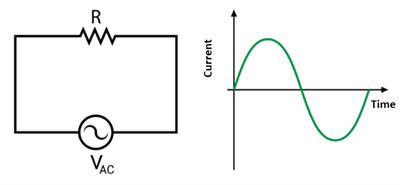PDF chapter test TRY NOW
If the direction of the current in a resistor or any other element changes its direction alternately, the current is called an Alternating current (ac).

ac circuit with graph
Advantages of Alternating current (ac) over Direct current (dc):
- A transformer can simply change the voltage of the alternating current (ac). Step-up transformers allow ac to be carried over great distances.
- The amount of energy lost while distributing alternating current is negligible. But, the direct current (dc) cannot be transmitted like alternating current (ac).
- It is easy to convert ac to dc, and it is also easier to generate alternating current than a direct current.
- The alternating current (ac) can generate electromagnetic induction, which can be beneficial in a variety of ways.
Important!
The voltage and frequency of ac used for domestic purposes in India are 220\ V and 50\ Hz, respectively, but in the United States of America, it is 110\ V and 60\ Hz, respectively.
Frequency:
The alternating current (ac) varies sinusoidally with time. This variation is known as frequency.
Frequency is the number of a complete cycle of variation gone through by the ac in one second.
The electrons in ac do not travel in one direction since the potential of the terminals alternates between high and low. As a result, electrons take to and fro motion in the wire carrying alternating current.
Rectifier and inverter:
Domestic power in our houses is provided in the form of ac. We must use a device to convert ac to dc while using an electrical gadget in direct current (dc).
The device used to convert ac to dc is called a Rectifier. It is also known as a battery eliminator or dc adaptor.
The device used to convert dc to ac is called an Inverter.
